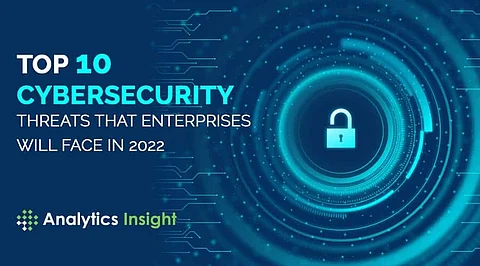

Cybersecurity is an enormous issue today. A host of new cybersecurity threats has the information security industry on high alert. Various types of cyberattacks involving malware, phishing, artificial intelligence, machine learning, and more are placing the sensitive data of businesses at constant risk. Every business, regardless of its size, is a potential target for cyberattacks. In 2021, cybercriminals took advantage of the coronavirus pandemic. The ongoing shift from remote to hybrid working conditions made the organizations vulnerable to ransomware. Skilled engineers and security architects have combined a preview of how the cybersecurity threat landscape would look in 2022. Experts believe that one of the greatest challenges that cybersecurity will face in 2022 is data breaches. In this article, we have listed the top 10 cybersecurity threats that enterprises will face in the coming year.
Ransomware Attacks:According to reports, the global ransomware attack volume increased by 151% during the first half of 2021 compared to 2020. Ransomware refers to the type of malware that can encrypt files if it enters inside the organization's network. Once inside, these files turn unusable along with the systems that rely on that information to run. Enterprises have to create a defined vulnerability program to mitigate and identify these threats efficiently and swiftly.
Social Engineering Threats:Sometimes, the sources of corporate hacks, leaks, and breaches are not the work of sophisticated hackers utilizing advanced technical approaches but are the results of simple social engineering threats. Criminals engaging in social engineering threats can gain access to information by manipulating the trust of the users, who might not be unaware of the looming security threats. These threats use human psychology to achieve nefarious goals and are quite common nowadays.
Data Security: As mentioned above, data breaches will become more common in 2022. Hackers often target data when they breach a system or database. They either have a financial motive or are conducting espionage against a particular country. In the first half of 2021, there were more than 18 million data breaches recorded globally, which is more than the population of the world. Everyday internet users add 2.5 trillion gigabytes of data, and this enormous amount of information reamins online without any robust security protection.
Increase in Social Media Privacy Breaches:Social media privacy breach is one of the most common types of cybersecurity With growing concerns about privacy breaches, people have started to put more focus on how social media companies gather and use the data. So, it almost seems inevitable that large-scale companies will change online privacy rules to better protect the users' information.
Increase in Supply Chain Attacks: Cyberattacks no longer just impacting the organizations but often have a ripple effect that harms, partners, providers, customers, and others who are involved in the supply chain. Supply chain attacks are becoming more common. Hence, governments have to devise regulations to protect these vulnerable networks. In the future, we might expect to see better collaboration between government officials and the private sector to identify such threats and combat them.
Weaponizing Deepfake Technology: There are many advanced tools to create fake but convincing videos and audios. Cybercriminals will increasingly use this technique to steal money, manipulate stock prices, and alter the opinions of people via social media.
Cloud Vulnerabilities: Almost every other business is using cloud technology to minimize the pressure from the enormous amounts of data on their internal hardware and electronic gadgets. Many of the tools and programs that companies use every day deploy cloud services. But not all cloud programs provide proper encryption and authentication. Before changing to the cloud, it is crucial to make sure that the businesses are using robust security measures within their framework.
IoT Vulnerabilities: IoT is the network of physical objects that are embedded with sensors and software to exchange data with other devices and systems. IoT attacks have increased in frequency. Infected routers were responsible for approximately 95 percent of the IoT attacks in 2019. Every IoT device that is added to home and business appliances provide an opportunity for attackers to exploit that device.
Credential Stuffing:Credential stuffing is a cyberattack in which the stolen credentials from a data breach are used to log into other related devices. Such attacks are on the rise because of the increase in the use of intelligent robots that simultaneously attempt several logins and appear to originate from different IP addresses.
Phishing: Lastly, phishing is one of the most common types of cyberattacks that attempts to fool employees into providing hackers personal data, such as usernames and passwords. Office employees might see thousands of emails and messages in a day. The sheer purpose of communicating might make them send sensitive information via a scam message or email, which might create havoc for the entire business.
Join our WhatsApp Channel to get the latest news, exclusives and videos on WhatsApp
_____________
Disclaimer: Analytics Insight does not provide financial advice or guidance. Also note that the cryptocurrencies mentioned/listed on the website could potentially be scams, i.e. designed to induce you to invest financial resources that may be lost forever and not be recoverable once investments are made. You are responsible for conducting your own research (DYOR) before making any investments. Read more here.
